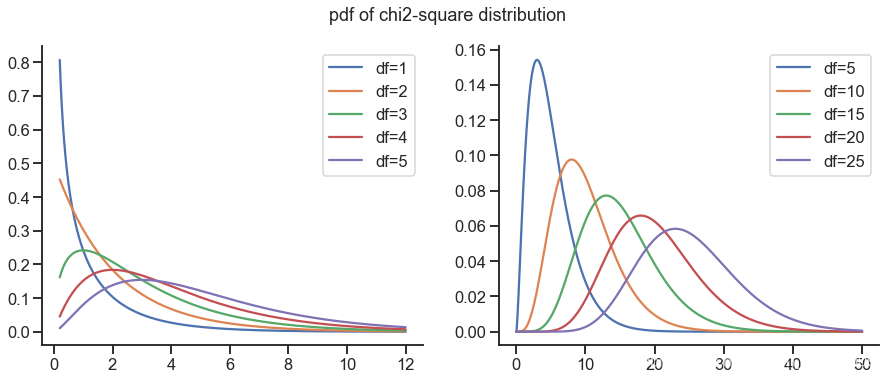import numpy as np
import matplotlib.pyplot as plt
import seaborn as sns
from scipy import stats
sns.set()
sns.set_style('ticks')
sns.set_context('talk')
%matplotlib inline
Normal distribution
x = np.linspace(-5, 5, 40)
plt.figure(figsize=(14, 5))
# probability density function
plt.subplot(121)
for sigma in (0.4, 1, 1.4):
plt.plot(x, stats.norm.pdf(x, loc=0, scale=sigma), label=f'$\sigma={sigma}$')
plt.legend()
sns.despine()
plt.title('pdf of normal distribution') #fontdict={'fontsize':16}
# cumulative distribution function
plt.subplot(122)
for sigma in (0.4, 1, 1.4):
plt.plot(x, stats.norm.cdf(x, loc=0, scale=sigma), label=f'$\sigma={sigma}$')
plt.legend()
sns.despine()
plt.title('cdf of normal distribution') #fontdict={'fontsize':16})
plt.show()

distribution
plt.figure(figsize=(15, 5.5))
plt.subplot(121)
x = np.linspace(0.2, 12, 2000)
for k in range(1, 6, 1):
plt.plot(x, stats.chi2.pdf(x, df=k), label=f'df={k}')
plt.legend()
sns.despine()
plt.subplot(122)
x = np.linspace(0, 50, 2000)
for k in range(5, 30, 5):
plt.plot(x, stats.chi2.pdf(x, df=k), label=f'df={k}')
plt.legend()
sns.despine()
plt.suptitle('pdf of chi2-square distribution', fontsize=18)
plt.show()

plt.figure(figsize=(15, 5.5))
plt.subplot(121)
x = np.linspace(0.2, 12, 2000)
for k in range(1, 6, 1):
plt.plot(x, stats.chi2.cdf(x, df=k), label=f'df={k}')
plt.legend()
sns.despine()
plt.subplot(122)
x = np.linspace(0, 50, 2000)
for k in range(5, 30, 5):
plt.plot(x, stats.chi2.cdf(x, df=k), label=f'df={k}')
plt.legend()
sns.despine()
plt.suptitle('cdf of chi2-square distribution', fontsize=18)
plt.show()

t-distribution
plt.figure(figsize=(7, 5))
x = np.linspace(-5, 5)
for k in range(1, 8, 2):
plt.plot(x, stats.t.pdf(x, df=k), label=f'df={k}')
plt.legend()
sns.despine()
plt.title('pdf of t distribution')
plt.show()

plt.figure(figsize=(7, 5))
x = np.linspace(-5, 5)
for k in range(1, 8, 2):
plt.plot(x, stats.t.cdf(x, df=k), label=f'df={k}')
plt.legend()
sns.despine()
plt.title('cdf of t distribution')
plt.show()

F-distribution
x = np.linspace(0.05, 5, 400)
plt.figure(figsize=(15, 5.5))
plt.subplot(121)
for d1, d2 in [(1, 1), (3, 1), (5, 2), (10, 2), (10, 10)]:
y = stats.f.pdf(x, d1, d2)
plt.ylim(-0.05, 1.75)
plt.plot(x, y, label=f'd1={d1}, d2={d2}')
plt.legend()
sns.despine()
plt.subplot(122)
for d1, d2 in [(1, 1), (1, 2), (2, 5), (1, 10), (30, 10)]:
y = stats.f.pdf(x, d1, d2)
plt.plot(x, y, label=f'd1={d1}, d2={d2}')
plt.legend()
sns.despine()
plt.suptitle('pdf of F distribution', fontsize=18)
plt.show()

x = np.linspace(0.05, 5, 400)
plt.figure(figsize=(15, 5.5))
plt.subplot(121)
for d1, d2 in [(1, 1), (3, 1), (5, 2), (10, 2), (10, 10)]:
y = stats.f.cdf(x, d1, d2)
plt.plot(x, y, label=f'd1={d1}, d2={d2}')
plt.legend()
sns.despine()
plt.subplot(122)
for d1, d2 in [(1, 1), (1, 2), (2, 5), (1, 10), (30, 10)]:
y = stats.f.cdf(x, d1, d2)
plt.plot(x, y, label=f'd1={d1}, d2={d2}')
plt.legend()
sns.despine()
plt.suptitle('cdf of F distribution', fontsize=18)
plt.show()

Beta distribution
x = np.linspace(0.05, 0.95, 400)
plt.figure(figsize=(15, 6))
plt.subplot(121)
for alpha, beta in [(0.5, 0.5), (5, 1), (1, 3), (1, 1), (2, 5)]:
plt.plot(x, stats.beta.pdf(x, alpha, beta), label=r'$\alpha={}, \beta={}$'.format(alpha, beta))
plt.legend()
sns.despine()
plt.title('pdf of Beta distribution')
plt.subplot(122)
for alpha, beta in [(0.5, 0.5), (5, 1), (1, 3), (2, 2), (2, 5)]:
plt.plot(x, stats.beta.cdf(x, alpha, beta), label=r'$\alpha={}, \beta={}$'.format(alpha, beta))
plt.legend()
sns.despine()
plt.title('cdf of Beta distribution')
plt.show()

对中心极限定理的验证
。
目标是考察
的分布情况
以参数为 1 的指数分布为例
sns.set_context('notebook')
plt.figure(figsize=(15, 15))
for i in range(1, 17):
plt.subplot(4, 4, i)
n = 4 * i
rvs = [
(np.random.exponential(size=n).sum() - n) / np.sqrt(n)
for _ in range(10000)
]
sns.distplot(rvs, kde=False)
plt.title(f"$n={n}$");sns.despine()
plt.show()

参数为 1 的泊松分布,这是一个离散型的分布
plt.figure(figsize=(15, 15))
for i in range(1, 17):
plt.subplot(4, 4, i)
n = 20 * i
rvs = [
(np.random.poisson(size=n).sum() - n) / np.sqrt(n)
for _ in range(5000)
]
sns.distplot(rvs, kde=False)
plt.title(f"$n={n}$");sns.despine()
plt.show()

从上面可以看到,对于一个连续型的分布,它的“标准型”能够更快的趋近于正态分布。而对于离散型分布而言,它所需要的 可能就比较大了。
